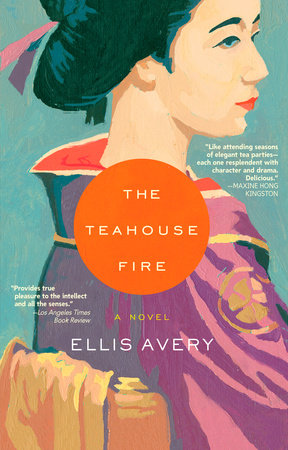The Teahouse Fire Reader’s Guide
By Ellis Avery


INTRODUCTION
“When I was nine, in the city now called Kyoto, I changed my fate. I walked into the shrine through the red arch and struck the bell. I bowed twice. I clapped twice. I whispered to the foreign goddess and bowed again. And then I heard the shouts and the fire. What I asked for? Any life but this one.” —The Teahouse Fire
The answer to Aurelia Bernard’s prayer—made at a Shinto shrine in the Japanese city of Miyako—comes in the form of a fire that consumes her Uncle Charles, the last blood relative she will ever know. The fatherless daughter of a French woman raised in New York City, Aurelia lost her mother on the eve of their departure for Japan with her Catholic missionary uncle. Now orphaned from both her family and her culture, she seeks refuge in the Baishian teahouse, where she is befriended by a beautiful young girl named Yukako, daughter of the great tea master who heads the Shin family. Despite Aurelia’s ignorance of their language and customs, the Shins take her into their household, giving her a new name, Urako, and introducing her to the ancient rites and rituals of Chado—the Way of Tea.
Ellis Avery’s The Teahouse Fire offers an intimate window onto the dramatic social upheavals of late-nineteenth-century Japan, as an ancient Eastern culture attempts to remake itself in the image of the rapidly modernizing West. The story of Urako—born of one society, educated in another, forever an outsider to both—mirrors the story of Meiji-era Japan as a whole, seduced by the strange new ideas of a foreign world but still tied to the ways of the past. Urako learns the temae, or steps, of the tea ceremony from the Shins, whose family has taught the ritual to Japan’s rulers for nearlythree centuries. At the same time, she is indoctrinated into the rigid social order of the day, where one’s position in society is determined by birth and a woman’s fate is determined by the wishes of her father and husband. But within a few years of Urako’s arrival these engrained traditions have begun to erode, bringing new hardships alongside new opportunities.
The Emperor declares the era one of Meiji, or “Enlightened Rule,” and the centuries-old social order of Japan vanishes overnight. The old caste system—with the venerated samurai on top and the despised eta, or “unclean,” as the lowest of the low—is abolished, and many fortunes reverse dramatically. The tea ceremony is declared an archaic “pastime” to be abandoned, and the imperial stipends that supported the Shins’ tea school, and the families of its samurai pupils, are abruptly discontinued. At the same time, the new social mobility of the era raises ambitious members of the merchant caste to positions of power and wealth, so much so that Yukako is gladly offered in marriage to a bumbling former pupil, whose merchant family’s affluence now far surpasses that of the young samurai she was once promised to—and whom she still loves.
But while the old traditions have been officially disavowed, there remains a craving amongst the newly elevated classes for the trappings of the old aristocracy. Seizing on this sentiment, Yukako revives her family’s business by tossing aside old taboos and teaching the once male-dominated Chado rituals to the young girls in the nation’s now-Westernized school system. As years and decades pass, Urako stays loyally by the side of her adopted “older sister,” accepting her role as dutiful vassal while secretly nurturing her desire for more. And eventually Yukako’s growing ambitions run aground, culminating in a heartbreaking evening tea ceremony that leaves both her relationship with Urako and their beloved Baishian teahouse in ashes.
Just for joining you’ll get personalized recommendations on your dashboard daily and features only for members.
Find Out More Join Now Sign In